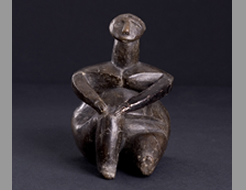|
||||||||||||||||||||||||||||||||
|
|
Museum of: Bucharest | |||||||||||||||||||||||||||||||
| Name of the artefact: The Seated Woman | ||||||||||||||||||||||||||||||||
|
The figurine, named The Seated Woman, was discovered
with the Thinker in the same funerary context |
||||||||||||||||||||||||||||||||
|
WHERE IS IT AND MAIN
CHARACTERISTICS |
STATE |
|||||||||||||||||||||||||||||||
|
Department: |
Archaeology |
Preservation: |
Good | |||||||||||||||||||||||||||||
|
Inventory number: |
15907 |
Restauration: |
Restored | |||||||||||||||||||||||||||||
|
Name of the artefact: |
The Seated Woman |
Completeness: |
Almost Complete | |||||||||||||||||||||||||||||
|
Object type: |
Human figurine |
|||||||||||||||||||||||||||||||
|
Material: |
Clay |
|||||||||||||||||||||||||||||||
|
Methof of manufacture: |
Shaping, firing |
|||||||||||||||||||||||||||||||
|
Decoration
type: |
No decoration |
|||||||||||||||||||||||||||||||
|
Distinctive mark: |
- |
|||||||||||||||||||||||||||||||
|
DIMENSIONS |
PERIOD OF USE |
|||||||||||||||||||||||||||||||
|
Length (mm): |
- |
Epoque: |
Neolithic |
|||||||||||||||||||||||||||||
|
Heigth
(mm): |
115 |
Culture: |
Hamangia |
|||||||||||||||||||||||||||||
|
Diameter
(mm): |
- |
Period: |
Late Neolithic |
|||||||||||||||||||||||||||||
|
Width (mm): |
54 |
Face: |
- |
|||||||||||||||||||||||||||||
|
Thickness (mm): |
- |
Absolute chronology: |
5000 BC |
|||||||||||||||||||||||||||||
|
Weight
(g): |
- |
|||||||||||||||||||||||||||||||
DISCOVERY |
||||||||||||||||||||||||||||||||
|
Date: |
1956 |
Country: |
Romania |
|||||||||||||||||||||||||||||
|
District: |
Constanţa |
Town hall affiliation: |
Columbia |
|||||||||||||||||||||||||||||
|
Village: |
Cernavodă |
Discovery findspot: |
Columbia |
|||||||||||||||||||||||||||||
|
Condition of discovery: |
Chance Discovery |
Discovery type: |
Grave |
|||||||||||||||||||||||||||||
|
ANALYSES – DETERMINATIONS |
FILLED IN BY |
|||||||||||||||||||||||||||||||
|
Type: |
- |
Name: |
Radian Andreescu, Katia
Moldoveanu |
|||||||||||||||||||||||||||||
|
Laboratory: |
- |
Institution: |
Romanian National History
Museum |
|||||||||||||||||||||||||||||
|
No./Code: |
- |
Date: |
23/02/2005 |
|||||||||||||||||||||||||||||
|
DEEPENINGS |
||||||||||||||||||||||||||||||||
|
Morphology of the object: |
||||||||||||||||||||||||||||||||
|
The statuette, companion of The Thinker, is named The
Seated Woman. It is made of dark-grey, polished clay and some parts of the
body are accentuated by sharp edges. A long neck supports the oval head.
The triangular impressions depict the eyes, the nose is modelled and a
small hole marks the mouth. The back is flat and the shoulders, the hips
and the abdomen are emphasized by exaggerating the modelling of these
areas. The stretched left leg is laid down and the right one is bending.
The hands are resting on the right knee suggesting a relaxing, resting
attitude. |
||||||||||||||||||||||||||||||||
|
Decoration: |
||||||||||||||||||||||||||||||||
|
- |
||||||||||||||||||||||||||||||||
|
Inscription: |
||||||||||||||||||||||||||||||||
|
- |
||||||||||||||||||||||||||||||||
|
Analogies: |
||||||||||||||||||||||||||||||||
|
The Seated Woman stands out among the other similar
figurines by the position in which it is modelled, even though they are
similar as morphology. Figurines modelled in resting position are very
rare, such an example being discovered in Thessaly, Greece. A rather
similar category is represented by the squatting figurines, holding with
their hands the tightly drown-up knees as discovered at Fafos, Vinča
culture, Sultana and Căscioarele, Gumelniţa culture. |
||||||||||||||||||||||||||||||||
|
Interpretation: |
||||||||||||||||||||||||||||||||
|
This statuette’s attitude of resting could suggest some
connection with death, considering that the artefact belongs to a funerary
context. |
||||||||||||||||||||||||||||||||
|
Bibliography: |
||||||||||||||||||||||||||||||||
|
Author: Berciu, D. Title: Deux chefs d'oeuvre de l'art
néolithique en Roumanie: le "couple" de la civilisation de Hamangia
Periodical: Dacia (N.S.) Volume: VI Place: Bucureşti Year: 1962 2. Author:
Berciu, D. Title: Contribuţii la problemele neoliticului în România în
lumina noilor cercetări Publishing House Place: Bucureşti Year: 1961 3.
Author: Dumitrescu, Vl. Title: Arta preistorică în România Place:
Bucureşti Year: 1974 |
||||||||||||||||||||||||||||||||

